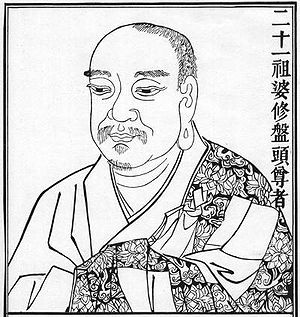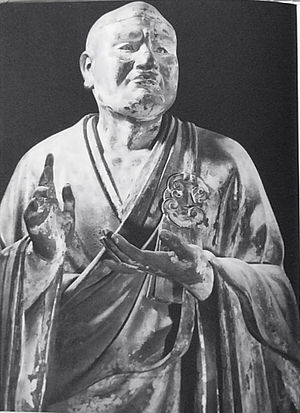Vasubandhu
Vasubandhu (T. Dbyig gnyen; C. Shiqin 世親) (fl. 4th to 5th century CE) was "one of the most influential authors in the history of Buddhism".[1] Contemporary scholar Jonathan C. Gold writes:
- The Buddhist philosopher Vasubandhu (4th century C.E.) was a great light at the peak of India's resplendent Gupta empire.[2] His works display his mastery of Buddhist as well as non-Buddhist thought of the day, and he made his mark, successively, upon three Buddhist scholastic traditions that are traditionally considered distinct: Vaibhāṣika, Sautrāntika, and Yogācāra.[3] His master work of Abhidharma thought, the Commentary on the Treasury of the Abhidharma (Abhidharmakośabhāṣya), is to this day the primary resource for knowledge of “Śrāvaka” or non-Mahāyāna philosophy among Tibetan and East Asian Buddhist schools. His three concise works on Yogācāra philosophy set a new standard for that school, which became mainstream Buddhist metaphysics in India for half a millennium thereafter.[4] Venerated as he is across the Buddhist world, he has always been a subject of disputation.[5]
Brief biography
Dan Lusthaus describes the early period of Vasubandhu's life as follows:
- Vasubandhu was born into a Hindu family at Puruṣapura (today called Peshawar) in the state of Gāndhāra in Northwestern India... At Vasubandhu's time the dominant Buddhist school in Gāndhāra was the Vaibhāṣika (also called Sarvāstivāda) because its main text was the Mahā-Vibhāṣā, a huge Sarvāstivādin Abhidharma treatise spelling out their positions on Buddhist classificatory schema. Vasubandhu studied this school and then traveled to the headquarters of the orthodox branch in Kashmir, studying with the leading teachers there. After returning home, according to tradition, during the day he would lecture on Vaibhāṣika doctrine and in the evening distill the day's lectures into a verse. When collected together the six-hundred-plus verses gave a thorough summary of the entire system; he entitled this work Abhidharma-kośa (Treasury of Abhidharma).[6]
The Abhidharma-kośa is considered an essential summary of early Abhidharma doctrine that is studied until this day.[5] However, after completing this summary, Vasubandhu then went on write a treatise on his own text, in which he criticized the Vaibhāṣika positions presented in his text from the point of view of the Sautrāntikas--another Buddhist school of this period that was critical of the Vaibhāṣika school. This commentary is known as the Abhidharmakośa-bhāṣya (Commentary on the Abhidharma-kośa).
Vasubandhu continued to refine his thinking,[6] and his writings evolved beyond the Sautrāntika point of view. He would eventually write major treatises that became foundational for (what would later be called) the Yogacara school of thought. Traditionally it is said that Vasubandhu's evolution towards Yogacara thought was due to the influence of has half-brother Asanga, who was another great thinker of this period.
Among his later treatises, three texts that become most influencial in East Asian Buddhism were the Viṃśatikā (Twenty stanzas on consciousness only), the Triṃśikā (Thirty stanzas on consciousness only), and the Treatise on the Three Natures.
Two Vasubandhus theory
Erich Frauwallner, a mid-20th-century Buddhologist, sought to distinguish two Vasubandhus, one the Yogācārin and the other a Sautrāntika, but this view has largely fallen from favour in part on the basis of the anonymous Abhidharma-dīpa, a critique of the Abhidharmakośakārikā which clearly identifies Vasubandhu as the sole author of both groups of writings.[7] According to Dan Lusthaus, "Since the progression and development of his thought ... is so strikingly evident in these works, and the similarity of vocabulary and style of argument so apparent across the texts, the theory of Two Vasubandhus has little merit."[8] Scholarly consensus on this question has generally moved away from Frauwallner's "two-authors" position.[9][5]
Works
Jonathan C. Gold writes:
- Vasubandhu composed works from the perspectives of several different philosophical schools. In addition, his works often state doctrinal positions and arguments with which he disagrees, in order to refute them. For this reason, scholars have used his works, especially his Commentary on the Treasury of the Abhidharma to explicate a range of Buddhist and non-Buddhist positions prevalent during his time.[5]
The writings attributed to Vasubandhu include:
His major work of Abhidharma thought:
- Commentary on the Treasury of the Abhidharma (Abhidharmakośabhāṣya)
A set of eight texts referred to as the Eight Treatises (Eight Prakarana):[10]
- Mahāyānasūtrālaṃkārabhāṣya (A commentary on The Ornament of the Mahayana Sutras)
- Madhyāntavibhāgabhāṣya (A commentary on Distinguishing the Middle from the Extremes)
- Dharmadharmatāvibhāgavṛtti (A commentary on Distinguishing Dharma and Dharmata)
- Vyākhyāyukti (Well Explained Reasoning)
- Karmasiddhi-prakaraṇa (Treatise on Karma)
- Pañcaskandhaprakaraṇa (Analysis of the Five Skandhas)
- Viṃśatikā (Twenty stanzas on consciousness only)
- Triṃśikā (Thirty stanzas on consciousness only)
Other works:
- Trisvabhāvanirdeśa - Treatise on the Three Natures
- Sukhāvatīvyūhopadeśa (Skt.), a treatise on the Amitayurdhyana Sutra
- A commentary on the Sūtra Teaching the Beginnings and the Divisions of Dependent Arising (Skt. Pratītyasamutpādādi-vibhaṅga-nirdeśa)
- Gāthāsaṃgrahaśāstra-nāma (Wyl. bstan bcos tshigs su bcad pa bsdus pa zhes bya ba)
- Gāthāsaṃgrahaśāstrārtha-nāma (Wyl. tshigs su bcad pa'i don bsdus pa zhes bya ba'i bstan bcos)
- Ekagāthābhāṣya (Wyl. tshigs su bcad pa gcig pa'i bshad pa)
- Vādavidhi ("Rules for Debate")
- Catuhśataka-śāstra
- Mahāyāna śatadharmā-prakāśamukha śāstra
- Amitayus sutropadeśa ("Instruction on the Amitabha Sutra")
- Discourse on the Pure Land[11]
- Vijnaptimatrata Sastra ("Treatise on representation only")
- Mahāyānasaṃgrahabhāṣya (Commentary to the Summary of the Great Vehicle of Asanga)
- Dasabhūmikabhāsya (Commentary on the Ten Stages Sutra)
- Commentary on the Aksayamatinirdesa-sutra
- Commentary on the Diamond Sutra
- Commentary on the Lotus Sutra[12][13]
- Paramärthasaptati, a critique of Samkhya
Major arguments and positions
For descriptions of Vasubandhu's major arguments and positions, see:
- Gold, Jonathan C., "Vasubandhu", The Stanford Encyclopedia of Philosophy (Summer 2018 Edition), Edward N. Zalta (ed.)
- Gold, Jonathan C., Paving the Great Way: Vasubandhu's Unifying Buddhist Philosophy, Columbia University Press: 2015
- Dan Lusthaus, Vasubandhu, Resources for East Asian Language and Thought, acmuller.net
Selected translations
- Abhidharma Kosha Bhashyam 4 vols, Vasubandhu, translated into English by Leo Pruden (based on Louis de la Vallée Poussin’s French translation), Asian Humanities Press, Berkeley, 1988-90.
- L’Abhidharmakosa de Vasubandhu, traduit et annoté par Louis de la Vallée Poussin, Paul Geuthner, Paris, 1923-1931 vol.1 vol.2 vol.3 vol.4 vol.5 vol.6 Internet Archive (PDF)
- Stefan Anacker, Seven Works of Vasubandhu Motilal Banarsidass, Delhi, 1984, 1998
- Ernst Steinkellner and Xuezhu Li (eds), Vasubandhu's Pañcaskandhaka (Wien, Verlag der Österreichischen Akademie der Wissenschaften, 2008) (Sanskrit Texts from the Tibetan Autonomous Region, 4).
- Dharmamitra, trans.; Vasubandhu's Treatise on the Bodhisattva Vow, Kalavinka Press 2009, ISBN 978-1-935413-09-7
Notes
- ↑ Robert E. Buswell Jr., Donald S. Lopez Jr., The Princeton Dictionary of Buddhism (Princeton: 2014), s.v. Vasubandhu
- ↑ "Vasubandhu's dating is contested, though Anacker's (1998) insightful biographical synthesis provides a convincing resolution to the most difficult problems. See Skilling (2000) and sources noted therein on the problem of authorship." (Gold, 2018)
- ↑ "Current scholarship not only calls into question the distinctiveness of the Sautrāntika school (Kritzer 2003), but also the solidity of the separation, once thought essential, between so-called “Śrāvaka” and “Mahāyāna” traditions up to and during Vasubandhu's lifetime." (Gold, 2018)
- ↑ "These are the Twenty Verses (Viṃśatikākārikā & Viṃśatikāvṛtti), the Thirty Verses (Triṃśikākārikā), and the Three Natures Exposition (Trisvabhāvanirdeśa)." (Gold, 2018)
- ↑ 5.0 5.1 5.2 5.3 Gold, Jonathan C., "Vasubandhu", The Stanford Encyclopedia of Philosophy (Summer 2018 Edition), Edward N. Zalta (ed.)
- ↑ 6.0 6.1 Dan Lusthaus, Vasubandhu, Resources for East Asian Language and Thought, acmuller.net
- ↑ Jaini, Padmanabh (1958). "On the Theory of Two Vasubandhus". Bulletin of the School of Oriental and African Studies (1): 48–53. doi:10.1017/s0041977x00063217. JSTOR 610489.
- ↑ Dan Lusthaus, "What is and isn't Yogacara.".
- ↑ Anacker, Stefan (2005). Seven Works of Vasubandhu. Delhi: MLBD. pp. 7–28.
- ↑
 Vasubandhu, Rigpa Shedra Wiki
Vasubandhu, Rigpa Shedra Wiki
- ↑ Matsumoto, David (2015). Jōdoron 浄土論: Discourse on the Pure Land, Pacific World: Third Series 17, 23-42
- ↑ Abbot, Terry Rae (1985). Vasubandhu´s Commentary to the Saddharmapundarika-sutra. PhD dissertation, Berkeley: University of California
- ↑ Abbot, Terry (2013). The Commentary on the Lotus Sutra, in: Tsugunari Kubo; Terry Abbott; Masao Ichishima; David Wellington Chappell, Tiantai Lotus Texts (PDF). Berkeley, California: Bukkyō Dendō Kyōkai America. pp. 83–149. ISBN 9781886439450.
References
- David J. Kalupahana, The Principles of Buddhist Psychology, State University of New York Press, Albany, 1987, pp 173–192.
- Francis H. Cook, Three Texts on Consciousness Only, Numata Center for Buddhist Translation and Research, Berkeley, 1999, pp 371–383 ("Thirty Verses on Consciousness Only") and pp 385–408 ("Twenty Verses on Consciousness Only")
- Erich Frauwallner, The Philosophy of Buddhism, Motilal Banarsidass, Delhi, 2010.
- Li Rongxi, Albert A. Dalia (2002). The Lives of Great Monks and Nuns, Berkeley CA: Numata Center for Translation and Research
- Thich Nhat Hanh Transformation at the Base (subtitle) Fifty Verses on the Nature of Consciousness, Parallax Press, Berkeley, 2001; inspired in part by Vasubandhu and his Twenty Verses and Thirty Verses texts
- Kochumuttom, Thomas (1982). A Buddhist Doctrine of Experience: A New Translation and Interpretation of the Works of Vasubandhu the Yogacarin. Delhi: Motilal Banarsidass
Further reading
- Gold, Jonathan C., Paving the Great Way: Vasubandhu's Unifying Buddhist Philosophy, Columbia University Press: 2015
- Gold, Jonathan C. "Vasubandhu". In Zalta, Edward N. Stanford Encyclopedia of Philosophy.
- Vasubandhu: Entry at the Internet Encyclopedia of Philosophy
- Vasubandhu’s Treatise on the Three Natures (Trisvabhāvanirdeśa) – A Translation and Commentary by Jay Garfield
| This article includes content from Vasubandhu on Wikipedia (view authors). License under CC BY-SA 3.0. |


